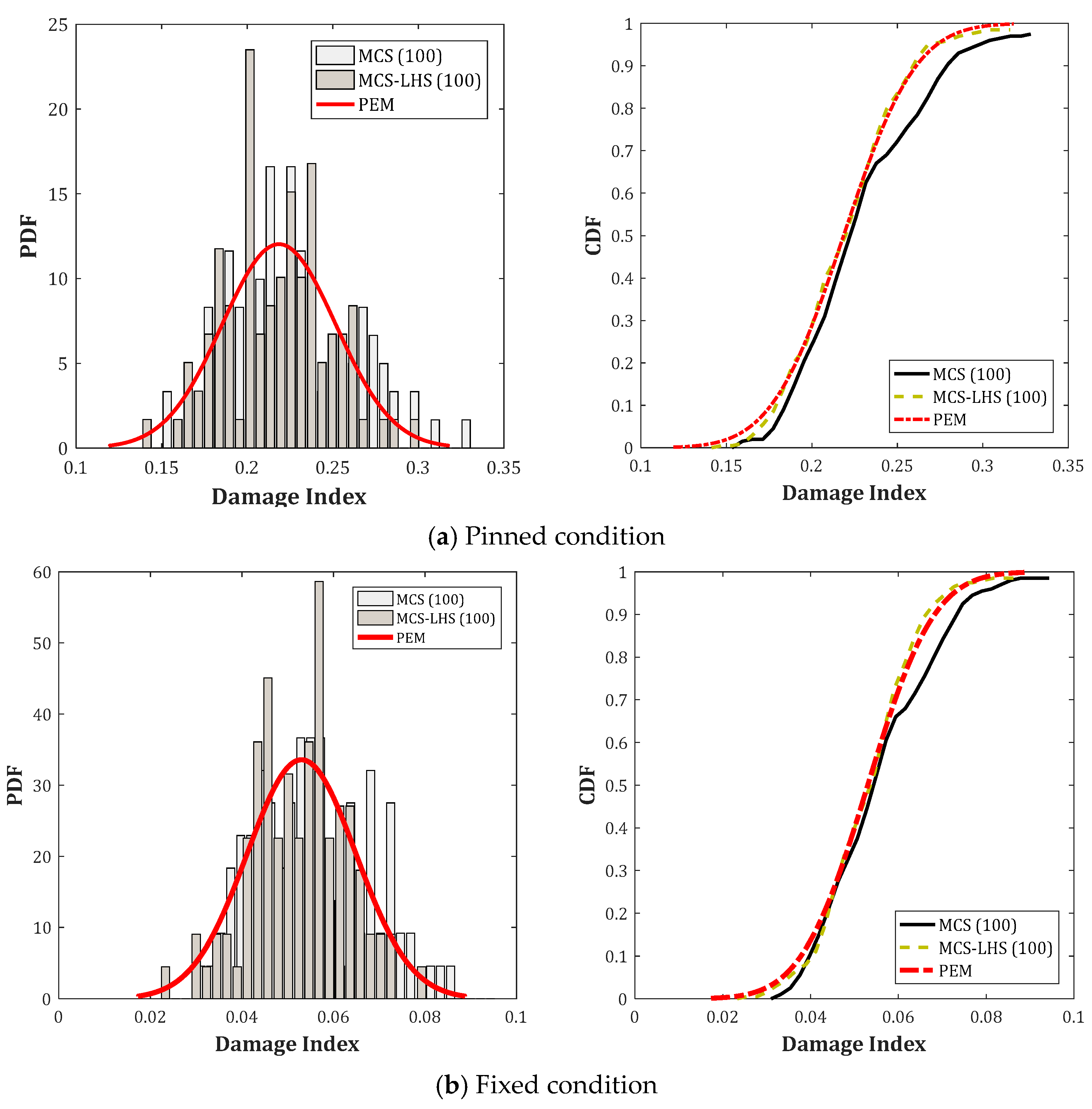Probabilistic Evaluation of Steel Column Damage under Blast Loading via Simulation Reliability Methods and Gene Expression Programming †
Abstract
:1. Introduction
2. Blast Loading
3. GEP Formulas
4. Reliability Methods and Uncertainties
5. Results and Discussion
6. Conclusions
Author Contributions
Funding
Institutional Review Board Statement
Informed Consent Statement
Data Availability Statement
Acknowledgments
Conflicts of Interest
References
- US DoD. Structures to Resist the Effects of Accidental Explosions; UFC 3-340-02: 2008; US DoD: Washington, DC, USA, 2008.
- Bounds, W.L. Design of Blast-Resistant Buildings in Petrochemical Facilities; ASCE Publications: Reston, VA, USA, 2010. [Google Scholar]
- Al-Thairy, H. A modified single degree of freedom method for the analysis of building steel columns subjected to explosion induced blast load. Int. J. Impact Eng. 2016, 94, 120–133. [Google Scholar] [CrossRef]
- Hadianfard, M.A.; Shekari, M. An Equivalent Single-Degree-of-Freedom System to Estimate Nonlinear Response of Semi-fixed Flexural Members Under Impact Load. Iran. J. Sci. Technol. Trans. Civ. Eng. 2019, 43, 343–355. [Google Scholar] [CrossRef]
- Momeni, M.; Hadianfard, M.A.; Bedon, C.; Baghlani, A. Numerical damage evaluation assessment of blast loaded steel columns with similar section properties. Structures 2019, 20, 189–203. [Google Scholar] [CrossRef]
- Bedon, C.; Amadio, C.; Sinico, A. Numerical and analytical investigation on the dynamic buckling behavior of glass columns under blast. Eng. Struct. 2014, 79, 322–340. [Google Scholar] [CrossRef]
- Hao, H.; Stewart, M.G.; Li, Z.-X.; Shi, Y. RC column failure probabilities to blast loads. Int. J. Prot. Struct. 2010, 1, 571–591. [Google Scholar] [CrossRef]
- Wu, C.; Hao, H. Safe scaled distance for masonry infilled RC frame structures subjected to airblast loads. J. Perform. Constr. Facil. 2007, 21, 422–431. [Google Scholar] [CrossRef]
- Momeni, M.; Bedon, C.; Hadianfard, M.A.; Baghlani, A. An Efficient Reliability-Based Approach for Evaluating Safe Scaled Distance of Steel Columns under Dynamic Blast Loads. Buildings 2021, 11, 606. [Google Scholar] [CrossRef]
- Hadianfard, M.A.; Malekpour, S.; Momeni, M. Reliability analysis of H-section steel columns under blast loading. Struct. Saf. 2018, 75, 45–56. [Google Scholar] [CrossRef]
- Momeni, M.; Bedon, C. Uncertainty Assessment for the Buckling Analysis of Glass Columns with Random Parameters. Int. J. Struct. Glass Adv. Mat. Res. 2020, 4, 254–275. [Google Scholar] [CrossRef]
- Stewart, M.G. Reliability-based load factor design model for explosive blast loading. Struct. Saf. 2018, 71, 13–23. [Google Scholar] [CrossRef]
- Netherton, M.D.; Stewart, M.G. Blast load variability and accuracy of blast load prediction models. Int. J. Prot. Struct. 2010, 1, 543–570. [Google Scholar] [CrossRef]
- Momeni, M.; Hadianfard, M.A.; Bedon, C.; Baghlani, A. Damage evaluation of H-section steel columns under impulsive blast loads via gene expression programming. Eng. Struct. 2020, 219, 110909. [Google Scholar] [CrossRef]
- Mays, G.; Smith, P. Blast Effect on Building: Design of Buildings to Optimize Resistance to Blast Loading; Thos Telford: London, UK, 1995. [Google Scholar]
- Ullah, A.; Ahmad, F.; Jang, H.-W.; Kim, S.-W.; Hong, J.-W. Review of analytical and empirical estimations for incident blast pressure. KSCE J. Civ. Eng. 2017, 21, 2211–2225. [Google Scholar] [CrossRef]
- Alkroosh, I.; Nikraz, H. Correlation of pile axial capacity and CPT data using gene expression programming. Geotech. Geol. Eng. 2011, 29, 725–748. [Google Scholar] [CrossRef]
- Bewick, B.; Flood, I.; Chen, Z. A neural-network model-based engineering tool for blast wall protection of structures. Int. J. Prot. Struct. 2011, 2, 159–176. [Google Scholar] [CrossRef]
- Ferreira, C. Gene Expression Programming: Mathematical Modeling by an Artificial Intelligence; Springer: Berlin/Heidelberg, Germany, 2006; Volume 21. [Google Scholar]
- Shi, Y.; Hao, H.; Li, Z.-X. Numerical derivation of pressure–impulse diagrams for prediction of RC column damage to blast loads. Int. J. Impact Eng. 2008, 35, 1213–1227. [Google Scholar] [CrossRef]
- Rosenblueth, E. Point estimates for probability moments. Proc. Natl. Acad. Sci. USA 1975, 72, 3812–3814. [Google Scholar] [CrossRef] [PubMed]

| Random Variable | Mean Value (μ) | Coefficient of Variation (COV) | Standard Deviation (σ) | Minimum Value | Maximum Value |
|---|---|---|---|---|---|
| Weff (kg of TNT) | 500 | 0.1 | 50.0 | 350.0 | 650.0 |
| R (m) | 10.0 | 0.1 | 1.0 | 7.0 | 13.0 |
| λmax (Pin) | 47.49 | 0.05 | 2.37 | 40.38 | 54.60 |
| λmax (Fix) | 23.74 | 0.05 | 1.18 | 20.20 | 27.28 |
| Fy (MPa) | 240.0 | 0.06 | 14.4 | 196.8 | 283.2 |
| Pd (kN) | 900.0 | 0.10 | 90.0 | 630.0 | 1170.0 |
Disclaimer/Publisher’s Note: The statements, opinions and data contained in all publications are solely those of the individual author(s) and contributor(s) and not of MDPI and/or the editor(s). MDPI and/or the editor(s) disclaim responsibility for any injury to people or property resulting from any ideas, methods, instructions or products referred to in the content. |
© 2023 by the authors. Licensee MDPI, Basel, Switzerland. This article is an open access article distributed under the terms and conditions of the Creative Commons Attribution (CC BY) license (https://creativecommons.org/licenses/by/4.0/).
Share and Cite
Momeni, M.; Bedon, C.; Hadianfard, M.A. Probabilistic Evaluation of Steel Column Damage under Blast Loading via Simulation Reliability Methods and Gene Expression Programming. Eng. Proc. 2023, 53, 20. https://doi.org/10.3390/IOCBD2023-15200
Momeni M, Bedon C, Hadianfard MA. Probabilistic Evaluation of Steel Column Damage under Blast Loading via Simulation Reliability Methods and Gene Expression Programming. Engineering Proceedings. 2023; 53(1):20. https://doi.org/10.3390/IOCBD2023-15200
Chicago/Turabian StyleMomeni, Mohammad, Chiara Bedon, and Mohammad Ali Hadianfard. 2023. "Probabilistic Evaluation of Steel Column Damage under Blast Loading via Simulation Reliability Methods and Gene Expression Programming" Engineering Proceedings 53, no. 1: 20. https://doi.org/10.3390/IOCBD2023-15200
APA StyleMomeni, M., Bedon, C., & Hadianfard, M. A. (2023). Probabilistic Evaluation of Steel Column Damage under Blast Loading via Simulation Reliability Methods and Gene Expression Programming. Engineering Proceedings, 53(1), 20. https://doi.org/10.3390/IOCBD2023-15200








